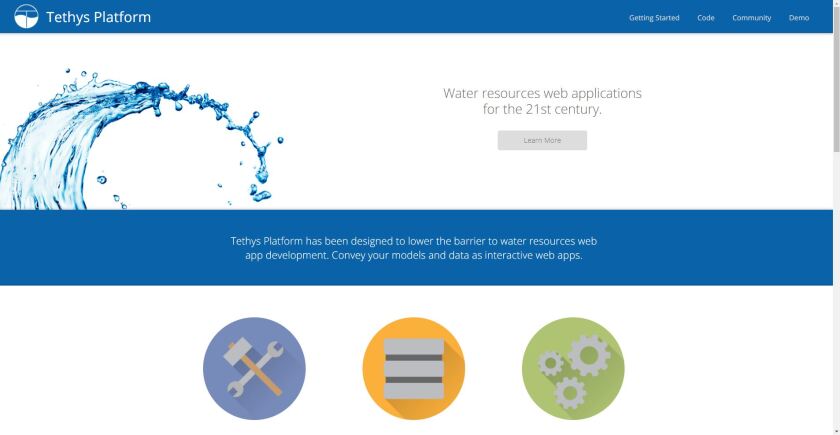Tethys Platform

Tethys Platform was originally developed at Brigham Young University as part of the CI-WATER project. CI-WATER was a cyberinfrastructure grant associated with the NSF EPSCoR program and involved four universities: Brigham Young University, the University of Utah, Utah State University, and the University of Wyoming. One of primary objectives of CI-WATER was to “Enhance access to data and computationally-intensive modeling“.
Tethys Platform is designed to help achieve this by providing a full suite of software development tools and resources, so scientists and engineers working in the field of water resource management can quickly and easily develop web apps for decision support. Tethys Platform was originally developed by Nathan Swain as part of his PhD research at BYU. Tethys is free and open source and has an active community of developers.
While Tethys “lowers the bar” to web app development, it still requires some training and programming skills. The objective of this website is to host a suite of resources that we have found to be helpful in building the basic skillset required to become proficient at Tethys development. We develop and maintain this material primarily for use by the undergraduate and graduate research assistants here at BYU in the Hydroinformatics Group, but we welcome everyone to use this material.
The usual Tethys platform interface is the following:

The BYU Hydroinformatics apps interface is the following:

BYU’s Role
The BYU Hydroinformatics environmental research group has the sacred function to create, innovate, give maintainance, debug in order to improve the applications that are displayed in this platform. Also, BYU provides training to students in different stages in their major so they are able to contribute with this magnificent goal.
Useful Links
Citations
Swain, N. R. (2015). Tethys platform Retrieved from https://search.lib.byu.edu/byu/record/lee.6680567
Dolder, H., N. Jones, and E.J. Nelson, “A simple methodology for using pre-computed hydrologic models in flood forecasting with uniform rainfall and soil moisture pattern.” Journal of Hydrologic Engineering. May 18, 2015. DOI:10.1061/(ASCE)HE.1943-5584.0001232
Christensen, S. D. (2016). A comprehensive python toolkit for harnessing cloud-based high-throughput computing to support hydrologic modeling workflows BYU ScholarsArchive. Retrieved from https://search.lib.byu.edu/byu/record/sa.etd-6666
Kadlec, J. (2016). Design, development and testing of web services for multi-sensor snow cover mapping BYU ScholarsArchive. Retrieved from https://search.lib.byu.edu/byu/record/sa.etd-6726
Swain, N. R. (2015). Tethys platform: A development and hosting platform for water resources web apps BYU ScholarsArchive. Retrieved from https://search.lib.byu.edu/byu/record/sa.etd-6831
Swain, Nathan R.; Alan D. Snow; Daniel P. Ames; E. James Nelson; Erfan Goharian; Gonzalo Espinoza-Dávalos; Herman Dolder; Norman L. Jones; Scott D. Christensen; Steven J. Burian.(2016) A new open source platform for lowering the barrier for environmental web app development.
Snow, A. D. (2015). A new global forecasting model to produce high-resolution stream forecasts Retrieved from https://search.lib.byu.edu/byu/record/lee.6590218
Crawley, S., Ames, D., Li, Z., & Tarboton, D. (2017). HydroShare GIS: Visualizing spatial data in the cloud BYU ScholarsArchive. Retrieved from https://search.lib.byu.edu/byu/record/sa.openwater-1081